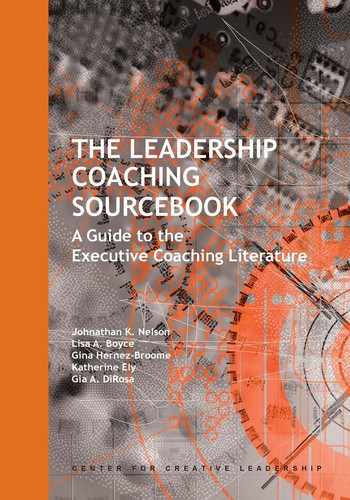Section 2. The Past and Current State of Executive Coaching
Executive coaching has witnessed an increase in popularity in both practice and research in the past two decades (Dagley, 2006; Passmore 2007). Although coaching and leader development efforts have been used in organizations for the past half century (Day, 2001; Kampa-Kokesch & Anderson, 2001), the term executive coaching was first coined in the 1980s in order to reduce the punitive stigma associated with coaching. However, practices were still predominantly corrective in nature and aimed at ineffective leaders (Kampa-Kokesch & Anderson, 2001). The practice of executive coaching substantially increased in the early 1990s, as faltering organizations attributed organizational problems to poor leadership. As a result, coaching maintained a punitive connotation (Feldman & Lankau, 2005) for another decade.
Only within the past decade has executive coaching evolved into a developmental opportunity and come to be perceived in a positive light for leaders (Feldman & Lankau, 2005). Today, coaches work closely with executives on long-term goals, daily activities, and interpersonal skills (Dean & Meyer, 2002; Hernez-Broome & Hughes, 2004; Jay, 2003). The success and subsequent demand for executive coaching has created an enormous growth in the number of professional coaches and coaching programs in organizations (Day, 2001; Dean & Meyer, 2002; Feldman & Lankau, 2005; Hernez-Broome & Hughes, 2004).
Despite the advent of executive coaching practices, the literature provides little consensus on a definition of executive coaching. However, the field appears to be reaching a convergence regarding the core components, as evidenced by several articles agreeing on what coaching is and what it is not. Executive coaching is, at its most fundamental level, a purposeful one-on-one relationship for developing effective leaders (Day, 2001; Dean & Meyer, 2002; Feldman & Lankau, 2005; Jay, 2005; Joo, 2005; Stern, 2004). Leadership coaching is not mentoring, training, consulting, or therapy (Feldman & Lankau, 2005; Hollenbeck, 2002; Kampa-Kokesch & Anderson, 2001; Passmore & Gibbes, 2007; Stern, 2004). We are partial to the Center for Creative Leadership (CCL) definition: “a practice in which the coach and coachee collaborate to assess and understand the developmental task, challenge current constraints while exploring new possibilities, and ensure accountability and support for reaching goals and sustaining development” (Ting & Hart, 2003, p. 116).
Similar to this definition, a range of terms are used to describe the participants in a coaching engagement. To be more comprehensive, we elected to incorporate many of these terms and to generally use them interchangeably. For example, executive coaching may also be referred to as leadership coaching, and clients may also be referred to as coachees.
The literature indicates several common goals that characterize executive coaching. Three predominant objectives of executive coaching are (a) developing self-awareness, (b) overcoming behaviors that limit personal and organizational success, and (c) building skills, particularly for high potentials, to support dynamic organizational needs (Anderson, Frankovelgia, & Hernez-Broome, 2009; Day, 2001; Dean & Meyer, 2002; Jay, 2005). Although these objectives focus on the individual, coaching also considers the individual as part of a larger system (Orenstein, 2002) and ultimately aims to foster organizational-level goals (Stern, 2004). Supplementary objectives often include increasing motivation and interpersonal skills (Dean & Meyer, 2002; Jay, 2005).
Two recent trends are expanding coaching objectives. First, changes in organizational functioning have elicited an increased need for both interpersonal skills and effective adaptability beyond simple business knowledge (Joo, 2005; Kampa-Kokesch & Anderson, 2001). Organizations have responded to these changes by taking a more vested interest in their human capital by incorporating coaching across human resource practices and growing a coaching culture (Anderson et al., 2009; Day, 2001). Second, coaching has received an increasing amount of attention from the fields of business and psychology (Day, 2001; Dean & Meyer, 2002; Kampa-Kokesch & Anderson, 2005). As a result, coaching practices are gaining an industrial-and-organizational-psychology perspective and the field is moving toward a science-practitioner model (McKenna & Davis, 2009).
Although research has responded to the trend, as evidenced by an increase in theoretical and empirical articles, much of the literature is still lagging practice, and many specifics of coaching theory and application remain unexplored (Feldman & Lankau, 2005; Hernez-Broome & Boyce, 2010; Joo, 2005; Kampa-Kokesch & Anderson, 2001). The following sections of the sourcebook will examine the state of the literature in more detail. Needless to say, executive coaching is an important and fruitful avenue for research and the development of evidence-based practices.
